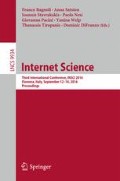Abstract
The purpose of this paper is to discuss challenges of measuring media pluralism and freedom in the digital age. We do this while presenting the updates of Media Pluralism Monitor implemented by the Centre for Media Pluralism and Media Freedom in three consecutive cycles (2014, 2015 and 2016). The paper explores methodological limitations and other pressing issues in regard to optimal assessment of risks to media pluralism in the digital environment.
Access this chapter
Tax calculation will be finalised at checkout
Purchases are for personal use only
Notes
- 1.
- 2.
Media Pluralism Monitor (MPM) was originally developed by the Katholieke Universiteit Leuven – ICRI, Central European University – CMCS and Jönköping International Business School – MMTC, together with a consultancy firm, Ernst & Young Belgium and subcontractors in all Member States. Subsequently, the European Commission has awarded several grants to the Centre for Media Pluralism and Media Freedom to conduct pilot implementations of the MPM.
- 3.
In 2014, the Monitor assessed the following nine countries: Belgium, Bulgaria, Denmark, Estonia, France, Greece, Hungary, Italy and the UK. In 2015, 19 EU countries that were not covered during the first pilot phase in 2014 were assessed: Austria, Croatia, Cyprus, Czech republic, Finland, Germany, Ireland, Latvia, Lithuania, Luxembourg, Malta, Netherlands, Poland, Portugal, Romania, Slovakia, Slovenia, Spain and Sweden. http://monitor.cmpf.eui.eu/mpm2015/results/#download.
- 4.
Most of the Internet access, coverage and usage variables rely on statistics from Eurostat.
- 5.
Akamai’s connection speed measures how quickly (in kilobits per second) data can be transferred from the Internet to a local computer. The data averages all of the connection speeds calculated over a period of time from the unique IP addresses determined to be in a specific country. Faris and Heacock Jones (2013) suggest that the sampling structure of Akamai’s data, based on a large proportion of Internet connections, has a more reliable measurement of speeds. Akamai source: https://www.akamai.com/us/en/our-thinking/state-of-the-Internet-report/.
- 6.
References
Braman, S.: Where has media policy gone? Defining the field in the twenty-first century. Commun. Law Policy 9(2), 153–182 (2004)
Belli, L., De Filippi, P.: Net Neutrality Compendium. Human Rights Free Competition and the Future of the Internet. Springer, Switzerland (2016)
Breindl, J.: Internet content regulation in liberal democracies. A literature review. Working Papers Digital Humanities 2. Göttingen Centre for Digital Humanities (2013). http://www.gcdh.de/files/1113/6549/2342/YBreindl_Literature_Review_Mar2013_final.pdf
Celot, P.: Assessing media literacy levels in Europe and the EC pilot initiative. In: EAVI (2015). http://www.eavi.eu/joomla/images/stories/About_EAVI/assessing.pdf
Craufurd Smith, R., Tambini, D., Morisi, D.: Regulating media plurality and media power in the 21st century. In: Broughton Micova, S., Tambini, D. (eds.) LSE Media Policy Project Series, Media Policy Brief 7. The London School of Economics and Political Science, London (2012)
Eurostat: Individual’s level of digital skills [isoc_sk_dskl_i] (2015). http://ec.europa.eu/eurostat/data/database?node_code=isoc_sk_dskl_i
Faris R., Heacock Jones R.: Measuring Internet Activity: A (Selective) Review of Methods and Metrics. Harvard University - Berkman Center for Internet & Society (2013). http://papers.ssrn.com/sol3/papers.cfm?abstract_id=2353457
Henrichsen, J.R., Betz, M., Lisosky, L.M.: Building Digital Safety for Journalists: A Survey of Selected Issues. Unesco Series on Internet Freedom. UNESCO, Paris (2015)
Karppinen, K.: Rethinking media pluralism and communicative abundance. Observatorio J. 11, 151–169 (2009)
Krueger, C.C, Swatman, P.M.C.: Who are the internet content providers? Identifying a realistic taxonomy of content providers in the online news sector. In: The Proceedings of IFIP I3E, Sao Paolo, Brazil (2003). http://www.cimne.com/simweb/formacion/ifipi3e.pdf
Murdoch, S.J., Anderson, R.: Tools and technologies of internet filtering. In: Ronald, J.D., Palfrey, J.G., Rohozinski, R., Zittrain, J. (eds.) Access Denied: The Practice and Policy of Global Internet Filtering. MIT Press, Cambridge (2008)
Author information
Authors and Affiliations
Corresponding author
Editor information
Editors and Affiliations
Appendix
Appendix
1.1 The MPM2016 Variables Focusing on the Digital Aspects of Media Pluralism
Basic protection
10. Are restrictions upon freedom of expression online clearly defined in law in accordance with international and regional human rights standards?
11. Are the restrictions to freedom of expression online ‘proportionate’ to the legitimate aim pursued’?
12. Does the state generally refrain from filtering and/or monitoring and/or blocking and/or removing online content in an arbitrary way?
13. Do the ISPs generally refrain from filtering and/or monitoring and/or blocking and/or removing online content in an arbitrary way?
29. Are there threats to the digital safety of journalists?
47. What percentage of the population is covered by broadband?
48. What percentage of the rural population is covered by broadband?
49. What is the percentage of broadband subscription in your country?
50. What is the average Internet connection speed in your country?
51. What is the percentage of market shares of the TOP 4 ISPs in your country?
52. Are there regulatory safeguards regarding net neutrality in your country?
Market Plurality
84. What is the market share of the Top4 Internet content providers?
85. What is the audience concentration for Internet content providers in your country?
105. Has expenditure for online advertising increased over the past two years?
107. Has the number of individuals regularly using the Internet increased over the past two years?
108. Has the number of individuals using mobile devices to access Internet on the move increased over the past two years?
Social Inclusiveness
143. What is the percentage of population that has at least basic digital usage skills?
144. What is the percentage of population that has at least basic digital communication skills?
Political Independence
166. (165. Are there self-regulatory measures that stipulate editorial independence in the news media?) Do these self-regulatory measures consider online news media?
Rights and permissions
Copyright information
© 2016 Springer International Publishing AG
About this paper
Cite this paper
Nenadic, I., Ostling, A. (2016). Assessing Media Pluralism in the Digital Age. In: Bagnoli, F., et al. Internet Science. INSCI 2016. Lecture Notes in Computer Science(), vol 9934. Springer, Cham. https://doi.org/10.1007/978-3-319-45982-0_20
Download citation
DOI: https://doi.org/10.1007/978-3-319-45982-0_20
Published:
Publisher Name: Springer, Cham
Print ISBN: 978-3-319-45981-3
Online ISBN: 978-3-319-45982-0
eBook Packages: Computer ScienceComputer Science (R0)

